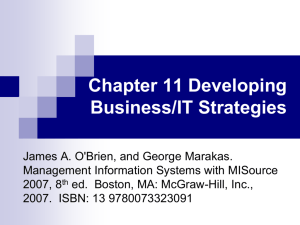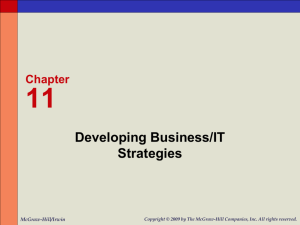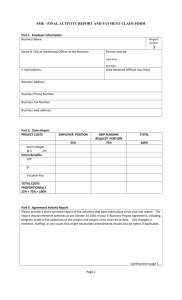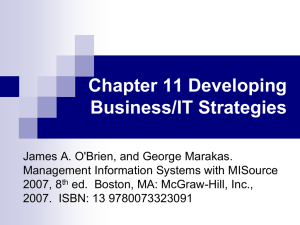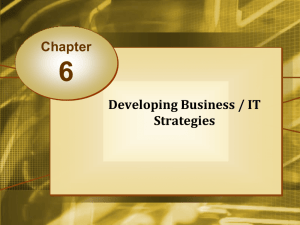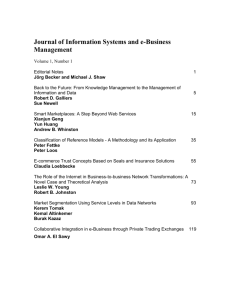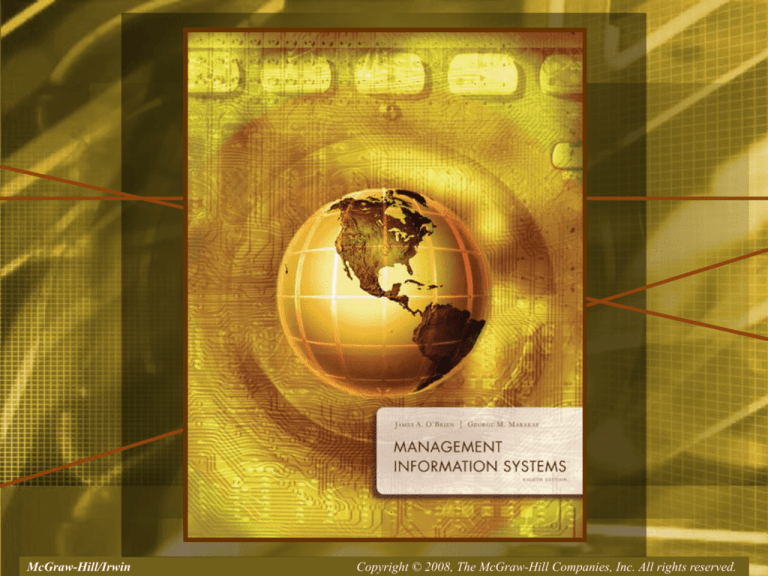
McGraw-Hill/Irwin
Copyright © 2008, The McGraw-Hill Companies, Inc. All rights reserved.
Chapter
11
Developing Business/IT Strategies
McGraw-Hill/Irwin
Copyright © 2008, The McGraw-Hill Companies, Inc. All rights reserved.
Learning Objectives
• Discuss the role of planning in the business
use of information technology, using the scenario
approach and planning for competitive advantage
as examples
• Discuss the role of planning and business models
in the development of business/IT strategies,
architectures, and applications
• Identify several change management solutions for
end user resistance to the implementation of new
IT-based business strategies and applications
1-3
Planning Fundamentals
• Information technology has created a seismic
shift in the way companies do business
• Just knowing the importance and structure of
e-business is not enough
• You must create and implement an action plan
that allows you to make the transition from an
old business design to a new e-business design
1-4
Case 1: The Portfolio Approach to IT
• 7-Eleven blends its IT investments with a range
of assertive IT practices and capabilities
• Counselor visits to stores twice a week
• Delivers of stock three times a day
• A transparent information infrastructure
that links 70,000 computers at stores,
headquarters, and supplier sites
1-5
Case 1: The Portfolio Approach to IT
• MIT identified four broad classifications of IT
investments that can be managed as a portfolio
to minimize business risk and optimize return
• Transactional: used to cut costs or increase
throughput for the same cost
• Informational: provide information for
accounting, reporting, compliance,
communication, or analysis
1-6
Case 1: The Portfolio Approach to IT
• Strategic: used to gain competitive advantage
by supporting entry into new markets or by
helping to develop new products, services, or
business products
• Infrastructure: typically aimed at providing
a flexible base for future business initiatives or
reducing long-term IT costs via consolidation
1-7
Case Study Questions
• What is the portfolio management approach
to IT planning?
• Use the four classifications of IT investments
and examples of companies in this case to
illustrate your answer
• What are the keys to 7-Eleven Japan’s great
success compared to other retailers in Japan?
• How does IT support such success?
• How could 7-Eleven Japan do even better?
• What role would IT play?
1-8
Components of Organizational Planning
1-9
Planning
• Strategic Planning
• Deals with the development of an organization’s
mission, goals, strategies, and policies
• Begins with strategic visioning questions
• Tactical Planning
• The setting of objectives and the development
of procedures, rules, schedules, and budgets
• Operational Planning
• Done on a short-term basis to implement and
control day-to-day operations
1-10
Strategic Visioning Questions
1-11
The Scenario Approach
• Gaining in popularity as a less formal, but more
realistic, strategic planning methodology
• Teams of managers and planners participate in
microworld or virtual world exercises
• Business scenarios are created and evaluated
• Alternative scenarios are then created
1-12
Trends that Affect Strategic Planning
1-13
Planning for Competitive Advantage
• Strategic business/IT planning
• Involves evaluating the potential benefits
and risks of using IT-based strategies and
technologies for competitive advantage
• The following models can help generate ideas
for the strategic use of IT to support initiatives
• Competitive forces
• Competitive strategies
• Value chain
1-14
Strategic Opportunities Matrix
1-15
SWOT Analysis
• SWOT stands for
• Strengths: a company’s core competencies
and resources
• Weaknesses: areas of substandard business
performance compared to others
• Opportunities: potential for new business
markets or innovative breakthroughs that
might expand current markets
• Threats: anything that has the potential for
business and market losses
1-16
Business Models and Planning
• Business model answers vital questions about
the fundamental components of a business
•
•
•
•
Who are our customers?
What do our customers value?
How much will it cost to deliver that value?
How do we make money in this business?
1-17
Questions for all Business Models
Customer value Are we offering something
distinctive or at a lower cost
than our competitors?
Scope
To which customers is this value
being offered?
What range of products/services
offered embody this value?
Pricing
How do we price the value?
1-18
Questions for all Business Models
Revenue source
Where do the dollars come from?
Who pays for what value and when?
What are the margins in each
market, and what drives them?
What drives value in each source?
Connected
activities
What do we have to do to offer this
value and when?
How connected are these activities?
1-19
Questions for all Business Models
Implementation What structure, systems, people, and
environment do we need to carry out
these activities?
What is the fit between them?
Sustainability
What is it about the firm that makes
it difficult for other to imitate it?
How do we keep making money?
How do we sustain our competitive
advantage?
1-20
Questions for all Business Models
Capabilities
What are our capabilities and
capabilities gaps?
How do we fill these gaps?
Is there something distinctive about
these capabilities that lets us offer
the value better than other firms?
Is this capability hard to imitate?
What are the sources of these
capabilities?
1-21
Questions Specific to E-Business Models
Customer
Value
What is it about Internet technologies
that allows us to offer customers
something distinctive?
Can Internet technologies help us
to solve a new set of problems for
customers?
Scope
What is the scope of customers that
Internet technologies enable us to
reach?
Does the Internet alter the product or
service mix that embodies the firm’s
products?
1-22
Questions Specific to E-Business Models
Pricing
How does the Internet make pricing
different?
Revenue source Are revenue sources different with
the Internet?
What is new?
Connected
activities
How many new activities must be
performed as a result of the Internet?
How much better can Internet
technologies help us perform
existing activities?
1-23
Questions Specific to E-Business Models
Implementation How do Internet technologies affect
the strategy, structure, systems,
people, and environment of the firm?
Capabilities
What new capabilities do we need?
What is the impact of Internet
technologies on existing capabilities?
Sustainability
Do Internet technologies make
sustainability easier or more difficult?
How can the firm take advantage
of it?
1-24
Business Models as Planning Tools
• A business model forces rigorously and
systematic thinking about the value and
viability of business initiatives
• The strategic planning process is then used
to develop unique business strategies that
capitalize on a business model
• The goal is to gain a competitive advantage
in an industry or marketplace
1-25
The Business/IT Planning Process
1-26
The Business/IT Planning Process
• The business/IT planning process has three
major components
• Strategic development
• Resource management
• Technology architecture
1-27
Information Technology Architecture
• The IT architecture is a conceptual design
that includes these major components
•
•
•
•
Technology platform
Data resources
Application architecture
IT organization
1-28
Balanced Scorecard
• The balanced scorecard measures a company’s
activities in terms of vision and strategies
• The system has four processes
• Translating vision into operational goals
• Communicating the vision and linking it
to individual performance
• Business planning
• Feedback/learning and strategy adjustment
1-29
Balanced Scorecard
• The business perspectives a scorecard measures
• Financial: reflects financial performance,
such as cash flow or ROI
• Customer: measures having a direct impact on
customers, such as time to process phone calls
• Business process: reflects the performance of key
business processes, such as time spent
prospecting or process costs
• Learning/growth: the company’s learning curve,
such as how many hours are spent training staff
1-30
Identifying Business/IT Strategies
• The most valuable Internet applications allow
companies to
•
•
•
•
Transcend communication barriers
Establish connections that enhance productivity
Stimulate innovative development
Improve customer relations
1-31
Strategic Positioning Matrix
1-32
Strategic Matrix
• Cost and Efficiency Improvements
• Use the Internet as a fast, low-cost way to
communicate and interact with others
• Use of e-mail, chat systems, discussion groups,
and company websites
• Performance Improvement in Effectiveness
• Major improvements in business effectiveness
recommended
• Increase use of Internet-based technologies,
such as intranets and extranets
1-33
Strategic Strategies
• Global Market Penetration
• Capitalize on a high degree of customer and
competitor connectivity and use of IT
• Use e-commerce websites with value-added
information services and extensive online
customer support
• Product and Service Transformation
• Develop and deploy new Internet-based
products and services that strategically
reposition it in the marketplace
1-34
E-Business Strategy Examples
• Market Creator: be among the first to market
and remain ahead of the competition by
continuously innovating
• Channel Reconfiguration: use the Internet
as a new channel to directly access customers,
make sales, and fulfill orders
• Transaction Intermediary: Use the Internet
to process purchases
1-35
E-Business Strategy Examples
• Infomediary: use the Internet to reduce the
search cost; offer a unified process for collecting
the information needed to make a large purchase
• Self-Service Innovator: provide a comprehensive
suite of services that the customer’s employees
can use directly
• Supply Chain Innovator: use the Internet to
streamline supply chain interactions
• Channel Mastery: use the Internet as a sales
and service channel
1-36
Business Application Planning Process
1-37
Comparing Planning Approaches
1-38
E-Business Architecture Planning
1-39
Implementation
• Many companies plan changes very well
• Few manage to convert a plan into action
• This is true even if senior management
consistently identifies e-business as an
area of great opportunity
1-40
Case 2: Infosys Implementation Challenges
• Company adage is “learn once, use everywhere”
• Developed a companywide knowledge
management program
• Offered knowledge currency units (KCUs)
for contributions to jump-start usage
• Issues encountered
•
•
•
•
•
Information overload
Slow searches for reusable information
Shortage of volunteer reviewers
Contributions of questionable quality
Information hoarding
1-41
Case 2: Infosys Implementation Challenges
• Revamped the System
• Formulated a composite KCU score based
on information usefulness and benefit
• Information rated by actual users
• Demanded justification for high ratings
• Reduced the number of KCUs awarded for
reviewing contributions
• Raised the bar for cashing in KCU incentive
points for monetary rewards
1-42
Case Study Questions
• Why do you think the knowledge management
system at Infosys faced such serious
implementation challenges?
• What steps did the KM group at Infosys take
to improve participation in the KM system?
• Why were some of these initiatives
counterproductive?
• The KM group responded well with corrective
initiatives. Do you think these will succeed?
1-43
Case Study Questions
• What change management initiatives should
the KM group have initiated in Infosys before
attempting to develop and implement
knowledge management at the company?
• Defend your proposals, paying particular
attention to the final quote in the case by
a long-time KM manager at Infosys
1-44
Implementing Information Technology
• Many businesses have undergone multiple
major reorganization since the early 1980s
•
•
•
•
•
•
•
•
Business process reengineering
Installation and upgrades of an ERP system
Upgrading legacy systems to be Y2K compliant
Creating shared service centers
Just-in-time manufacturing
Sales force automation
Contract manufacturing
The introduction of euro currency
• E-business is the latest organizational change
1-45
Impact and Scope of Implementing IT
1-46
Intranet Enterprise Portal Challenges
•
•
•
•
•
•
•
•
•
•
Security, security, security
Defining the scope and purpose of the portal
Finding the time and the money
Ensuring consistent data quality
Getting employees to use it
Organizing the data
Finding technical expertise
Integrating the pieces
Making it easy to use
Providing all users with access
1-47
Enterprise Resource Planning Challenges
•
•
•
•
•
•
•
•
•
•
Getting end user buy-in
Scheduling/planning
Integrating legacy systems/data
Getting management buy-in
Multiple/international sites and partners
Changing culture and mind-sets
IT training
Getting, keeping IT staff
Moving to a new platform
Performance/system upgrades
1-48
End User Resistance and Involvement
• Any way of doing things generates some
resistance from the people affected
• CRM projects have a history of failure
• Up to 75 percent of CRM projects fail to
meet their objectives
• This is often due to sales force automation
problems and unaddressed cultural issues
• Sales staffs are often resistant to, or fearful
of, using CRM systems
1-49
Keys to Solving End User Resistance
• Keys to solving end user resistance problems
• Education and training
• End-user involvement in organizational
changes and system development
• Requiring involvement and commitment of
top management and all stakeholders
• Systems that inconvenience or frustrate users
cannot be effective, no matter how technically
elegant or efficient
1-50
Obstacles to KM Systems
1-51
Change Management
People factors have the highest level
of difficulty and the longest time to resolve
of any dimension of change management
1-52
Key Dimensions of Change Management
1-53
Change Management
• Implementing a new e-business application
may involve
•
•
•
•
Developing an action plan
Assigning managers as change sponsors
Developing employee change teams
Encouraging open communications and
feedback about organizational changes
1-54
Change Management
• Key tactics recommended by change experts
• Involve as many people as possible in e-business
planning and application development
• Make constant change an expected part
of the culture
• Tell everyone as much as possible about
everything, as often as possible, in person
• Make liberal use of financial incentives and
recognition
• Work within the company culture, not around it
1-55
A Change Management Process
1-56
Avnet Marshall’s Transformation
1-57
Case 3: Strategies of Second Movers
• Gain an edge by observing what the first
mover has done
•
•
•
•
•
Be better, faster, cheaper, easier
Trip up incumbents with tactics from other fields
Swipe business models and start your own race
Follow the biggest leader you can find
Aim for the leader’s Achilles’ heel
1-58
Case Study Questions
• Is the second-mover advantage always a
good planning strategy?
• What can a front-runner business do to foil
the assaults of second movers?
• Do second movers always have the
advantage in Web-based business success?
1-59
Case 4: Planning for Innovation
• Federal Express spends $1 billion/year on IT
• Primary focus is on revenue-generating,
customer-satisfaction-generating, and
strategic-advantage technology
• Operational technology receives slightly
less attention
• Company philosophies
• It’s easier to copy than to innovate
• Move, communicate, and shoot
1-60
Case Study Questions
• How do the IT investment strategies and focus
of FedEx and its main competitor UPS differ?
• Which company has the better strategy?
• Is FedEx’s “move, communicate, shoot” IT
strategy a good one for its competitive battle
with UPS?
• Is it a good model of competitive IT strategy for
other types of companies?
1-61
Case Study Questions
• FedEx CIO Carter says his company is in the
business of engineering time.
• Is this a good business vision for FedEx?
• How vital is IT to this definition of FedEx’s
business?
1-62

